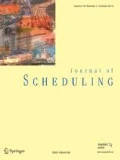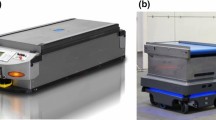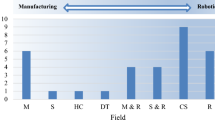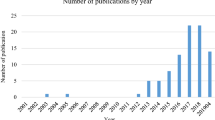Abstract
The semiconductor manufacturing industry is significantly expensive both in equipment and materials. Cluster tools, a type of automated manufacturing system integrating processing modules and transport modules, are commonly used in this industry. Nowadays, multi-cluster tools, which are composed of several cluster tools connected by joint buffer modules, are often used for wafer production. This paper deals with K-unit cycle scheduling problems in single-armed two-cluster tools for processing identical wafers in deterministic settings. In a K-unit cycle, K wafers are exactly inserted into the two-cluster tool, and K completed wafers leave the two-cluster tool, usually not the same K wafers. Residency constraints and general moving times by the robot are both considered. The objective is to obtain optimal K-unit cycle schedules, which minimize cycle times. To analyze this scheduling problem in detail, a mixed integer linear programming (MILP) model is formulated and solved. Numerical examples are used to explain how the solution can be obtained from the MILP model in a K-unit cycle.







Similar content being viewed by others
References
Armstrong, R., Lei, L., & Gu, S. (1994). A bounding scheme for deriving the minimal cycle time of a single-transporter n-stage process with time-window constraints. European Journal of Operational Research, 78(1), 130–140.
Carlier, J., Haouari, M., Kharbeche, M., & Moukrim, A. (2010). An optimization-based heuristic for the robotic cell problem. European Journal of Operational Research, 202(3), 636–645.
Chan, W. K., Yi, J., Ding, S. & Song, D. ( 2008). Optimal scheduling of k-unit production of cluster tools with single-blade robots. In Proceedings of 4th IEEE international conference on automation science and engineering, CASE 2008 (pp. 335–340).
Chan, W. K. V., Ding, S., Yi, J., & Song, D. (2011a). Optimal scheduling of multicluster tools with constant robot moving times, part II: Tree-like topology configurations. IEEE Transactions on Automation Science and Engineering, 8(1), 17–28.
Chan, W. K. V., Yi, J., & Ding, S. (2011b). Optimal scheduling of multicluster tools with constant robot moving times, part I: Two-cluster analysis. IEEE Transactions on Automation Science and Engineering, 8(1), 5–16.
Che, A., Lei, W., Feng, J. & Chu, C. ( 2014). An improved mixed integer programming approach for multi-hoist cyclic scheduling problem. IEEE Transactions on Automation Science and Engineering, 11(1), 302–309.
Chen, H., Chu, C., & Proth, J.-M. (1998). Cyclic scheduling of a hoist with time window constraints. IEEE Transactions on Robotics and Automation, 14(1), 144–152.
Crama, Y., & van de Klundert, J. (1997). Cyclic scheduling of identical parts in a robotic cell. Operations Research, 45(6), 952–965.
Dawande, M., Geismar, H. N., Sethi, S. P., & Sriskandarajah, C. (2005). Sequencing and scheduling in robotic cells: Recent developments. Journal of Scheduling, 8(5), 387–426.
Dawande M. W., Geismar, H. N., Sethi, S. P. & Sriskandarajah, C. (2007). Throughput optimization in robotic cells in international series in operations research and management science (Vol. 101). New York, NY: Springer, LLC.
Dawande, M., Geismar, H. N., Pinedo, M., & Sriskandarajah, C. (2010). Throughput optimization in dual-gripper interval robotic cells. IIE Transactions, 42(1), 1–15.
Geismar, H. N., Dawande, M., & Sriskandarajah, C. (2005). Approximation algorithms for k-unit cyclic solutions in robotic cells. European Journal of Operational Research, 162(2), 291–309.
Geismar, H. N., Chan, L. M. A., Dawande, M., & Sriskandarajah, C. (2008). Approximations to optimal k-unit cycles for single-gripper and dual-gripper robotic cells. Production and Operations Management, 17(5), 551–563.
Geismar, H. N., Pinedo, M., & Sriskandarajah, C. (2008). Robotic cells with parallel machines and multiple dual gripper robots: A comparative overview. IIE Transactions, 40(12), 1211–1227.
Geismar, N., Dawande, M., & Sriskandarajah, C. (2011). Productivity improvement from using machine buffers in dual-gripper cluster tools. IEEE Transactions on Automation Science and Engineering, 8(1), 29–41.
Geismar, N., Manoj, U. V., Sethi, A., & Sriskandarajah, C. (2012). Scheduling robotic cells served by a dual-arm robot. IIE Transactions, 44(3), 230–248.
Jung, C., & Lee, T.-E. (2012). An efficient mixed integer programming model based on timed petri nets for diverse complex cluster tool scheduling problems. IEEE Transactions on Semiconductor Manufacturing, 25(2), 186–199.
Kamoun, H., Hall, N. G., & Sriskandarajah, C. (1999). Scheduling in robotic cells: Heuristics and cell design. Operations Research, 47(6), 821–835.
Kats, V., & Levner, E. (2002). Cyclic scheduling in a robotic production line. Journal of Scheduling, 5(1), 23–41.
Kats, V., & Levner, E. (2011a). A faster algorithm for 2-cyclic robotic scheduling with a fixed robot route and interval processing times. European Journal of Operational Research, 209(1), 51–56.
Kats, V., & Levner, E. (2011b). Parametric algorithm for 2-cyclic robot scheduling with interval processing times. Journal of Scheduling, 14(2), 267–279.
Kharbeche, M., Carlier, J., Haouari, M., & Moukrim, A. (2011). Exact methods for the robotic cell problem. Flexible Services and Manufacturing Journal, 23(2), 242–261.
Lei, L. & Wang, T. J. (1989). A proof: The cyclic hoist scheduling problem is np-complete. Working paper 89-0016. New Brunswick, NJ: Rutgers University.
Leung, J. M. Y., Zhang, G., Yang, X., Mak, R., & Lam, K. (2004). Optimal cyclic multi-hoist scheduling: A mixed integer programming approach. Operations Research, 52(6), 965–976.
Li, X. & Fung, R. Y. K. ( 2013). A mixed integer linear programming approach for multi-degree cyclic multi-hoist scheduling problems without overlapping. In 2013 IEEE international conference on automation science and engineering (CASE) (pp. 274–279).
Li, X., Fung, R. Y. K. & Sun, H. (2011). An events-driven scheduling algorithm for two-cluster tools with processing time windows. In 2011 IEEE international conference on industrial engineering and engineering management (IEEM) (pp. 1436–1440).
Li, X., & Fung, R. Y. K. (2014). A mixed integer linear programming solution for single hoist multi-degree cyclic scheduling with reentrance. Engineering Optimization, 46(5), 704–723.
Monch, L., Fowler, J. W., Dauzere-Peres, S., Mason, S. J., & Rose, O. (2011). A survey of problems, solution techniques, and future challenges in scheduling semiconductor manufacturing operations. Journal of Scheduling, 14(6), 583–599.
Phillips, L. W., & Unger, P. S. (1976). Mathematical programming solution of a hoist scheduling program. AIIE Transactions, 8(2), 219–225.
Sethi, S., Sriskandarajah, C., Sorger, G., Blazewicz, J., & Kubiak, W. (1992). Sequencing of parts and robot moves in a robotic cell. International Journal of Flexible Manufacturing Systems, 4(3–4), 331–358.
van Zant, P. (2004). Microchip fabrication: A practical guide to semiconductor processing (5th ed.). New York: McGraw-Hill.
Wu, N., & Zhou, M. (2012). Modeling, analysis and control of dual-arm cluster tools with residency time constraint and activity time variation based on petri nets. IEEE Transactions on Automation Science and Engineering, 9(2), 446–454.
Yang, F., Wu, N., Qiao, Y., & Zhou, M. (2014). Optimal one-wafer cyclic scheduling of single-arm multicluster tools with two-space buffering modules. IEEE Transactions on Systems, Man, and Cybernetics: Systems, 44(12), 1584–1597.
Yoon, H. J., & Lee, D. Y. (2005). Online scheduling of integrated single-wafer processing tools with temporal constraints. IEEE Transactions on Semiconductor Manufacturing, 18(3), 390–398.
Zhou, Z., Che, A., & Yan, P. (2012). A mixed integer programming approach for multi-cyclic robotic flowshop scheduling with time window constraints. Applied Mathematical Modelling, 36(8), 3621–3629.
Zhou, Z., & Li, L. (2009). A solution for cyclic scheduling of multi-hoists without overlapping. Annals of Operations Research, 168(1), 5–21.
Zhu, Q., Wu, N., Qiao, Y., & Zhou, M. (2013). Petri net-based optimal one-wafer scheduling of single-arm multi-cluster tools in semiconductor manufacturing. IEEE Transactions on Semiconductor Manufacturing, 26(4), 578–591.
Acknowledgments
The work described in this paper was supported by a Research Grant from General Research Fund (GRF) of Hong Kong (RGC # CityU 113609).
Author information
Authors and Affiliations
Corresponding author
Rights and permissions
About this article
Cite this article
Li, X., Fung, R.Y.K. Optimal K-unit cycle scheduling of two-cluster tools with residency constraints and general robot moving times. J Sched 19, 165–176 (2016). https://doi.org/10.1007/s10951-015-0448-7
Published:
Issue Date:
DOI: https://doi.org/10.1007/s10951-015-0448-7




